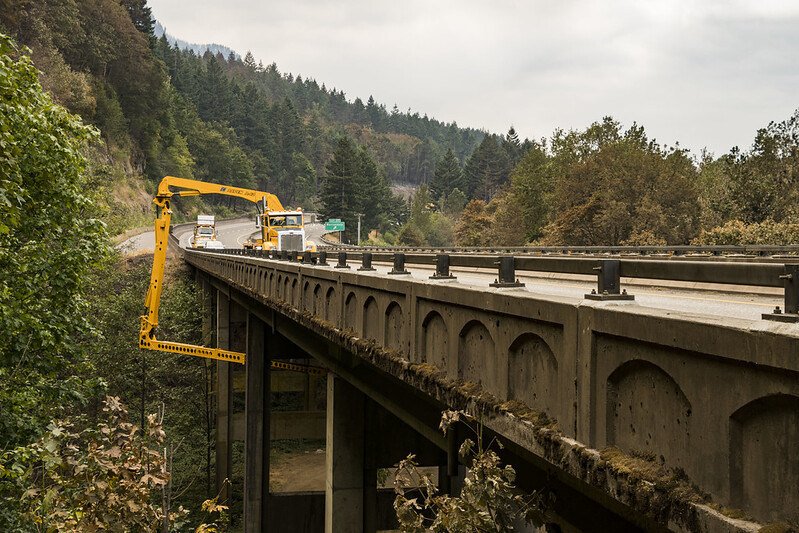ODOT issues yearly bridge condition report: A boost in funding, but needs still tower tall

SALEM, Ore. (KTVZ) -- This year’s Oregon Department of Transportation report on the condition of Oregon's bridges is clear, the agency said Wednesday: ODOT needs a continuous, stable funding source to maintain and upgrade our bridges in the coming decades.
"Although a substantial amount of money has been added to ODOT’s budget with the recent infusion of federal and state funds, we still fall short of meeting all the needs that have been delayed," ODOT says in Wednesday's announcement, which continues in full below:
The current annual report, which ranks bridges from poor to good, shows a decline in bridge conditions for the tenth straight year.
In the last two years, 53 bridges had declining overall condition ratings versus 25 bridges with improved condition ratings. As Oregon bridges continue to age, ODOT had reduced the number of bridges that are in poor condition, but the number of bridges in good condition is also declining each year. As a result, the number of bridges in fair condition continues to increase.
Unsustainable Fix-It Route Strategy
In the past, ODOT has used the Fix-It Route strategy — a strategy that repairs or replaces bridges along critical corridors. However, this is not a sustainable long term strategy. There continue to be many significant needs that are not on Fix-It Routes, but are still vital to individuals and businesses.
The reality is that most of the state’s 2,766 bridges were all designed and built decades ago, when the population of people and cars was far lower. These aging bridges are now at or exceeding their life expectancy.
ODOT replaces a small number of bridges each year and provides short-term improvements on existing bridges. As bridge conditions continue to deteriorate, the risk of bridge load restrictions and closures will increase.
Upcoming Bridge Load Restrictions
ODOT's current highway bill, Fixing America’s Surface Transportation Act, made it legal for very large, multiple-axle emergency vehicles to travel on the interstate system to respond to events such as wildland fires and other natural disasters.
To ensure that our aging bridges can accommodate these heavy vehicles, the Federal Highway Administration mandated that all states must load rate all bridges within one mile of interstate routes and post load restrictions if necessary. ODOT identified 84 bridges that meet this criteria and will require load restrictions for very heavy emergency vehicles.
ODOT's Seismic Program Making Progress
The good news is that ODOT is making steady progress on our seismic resilience projects. As of September 2021, the agency says it addressed all vulnerable bridges on the northern half of U.S. Highway 97, and the southern half is ready to begin construction.
ODOT says it is also making progress on seismic upgrades to our southern Oregon bridges. This effort is divided into four projects. This effort is divided into four projects. The first project is complete and the second project is in construction. They are designing the other two.
The I-205 Improvement Project will address the seismic vulnerability of nine bridges by either retrofitting or replacing them based on a cost/benefit analysis. The Abernethy Bridge will be retrofitted and afterwards will be the first major river crossing in Oregon expected to remain operational after a major seismic event.
In the future, there will be more opportunities to apply for additional funds from the Infrastructure Investment and Jobs Act discretionary grants to make major improvements to Oregon's bridges, which contribute toward a thriving economy.
The list of bridges that will have projects funded by the new bill is still being developed and will be presented at the Oregon Transportation Commission meeting in March. A portion of the new federal bridge funding will go to local cities and counties. ODOT is working with local governments to determine how to split the funding between state and local bridges.
Through the Bridge Investment Program, which is part of the federal infrastructure package you mentioned, Oregon can expect to receive around $40 million annually for five years for investing in bridges.
While this is a significant infusion of resources, at about $40 million a year for ODOT bridges, it is about a one-third increase in the State Bridge Program. Given the massive needs for our aging bridges, even with this additional infusion of funding we still expect to see bridge conditions deteriorate over time.
The majority of ODOT’s bridges are over 50 years old — the age at which they should be heading toward retirement. With a huge number of bridges reaching the end of their lifespan, we are currently only investing about one-third of what we need to keep them in a state of good repair.
We have nearly 2,800 bridges on the state highway system, and we’re currently replacing on average three per year, for a replacement cycle of nearly 900 years.
To learn more about the condition of Oregon’s bridges, read ODOT's 2021 Bridge Conditions Report on their Bridge Section website.